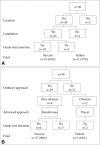Clin Endosc.
2012 Sep;45(3):189-193.
Endoscopic Approach via the Minor Papilla for the Treatment of Pancreatic Stones
- Affiliations
-
- 1Department of Gastroenterology and Metabolism, Nagoya City University Graduate School of Medical Sciences, Nagoya, Japan. tnakazaw@med.nagoya-cu.ac.jp
Abstract
- BACKGROUND/AIMS
We aimed to evaluate whether the advanced techniques have influenced the minor papilla approach.
METHODS
We studied the success rate of guide wire insertion by using ordinary techniques and advanced techniques (rendezvous method and precut method) in 30 patients via the minor papilla. We compared the selection of the access routes between before (52 patients) and after (28 patients) the introduction of the Soehendra stent retriever.
RESULTS
In 19 out of 30 patients (63%), guide wire insertion via the minor papilla could be achieved by using ordinary techniques. In total, the guide wire could be inserted in 27 patients (90%) by using the advanced techniques. Before introduction of the Soehendra stent retriever, the major papilla approach was chosen in 38 cases (73%), and the minor papilla approach in 14 cases (27%). After introduction of the Soehendra stent retriever, the major papilla approach was used in 26 cases (93%) and the minor papilla in 2 cases (7%). The frequency of selecting the minor papilla approach has significantly decreased (p<0.05).
CONCLUSIONS
The advanced techniques have contributed to the improvement of endoscopic approaches via the minor papilla, and decreased the frequency of selecting the minor papilla approach.
Figure
Reference
-
1. Ertan A. Long-term results after endoscopic pancreatic stent placement without pancreatic papillotomy in acute recurrent pancreatitis due to pancreas divisum. Gastrointest Endosc. 2000; 52:9–14. PMID: 10882955.
Article2. Song MH, Kim MH, Lee SK, et al. Endoscopic minor papilla interventions in patients without pancreas divisum. Gastrointest Endosc. 2004; 59:901–905. PMID: 15173812.
Article3. Inui K, Tazuma S, Yamaguchi T, et al. Treatment of pancreatic stones with extracorporeal shock wave lithotripsy: results of a multicenter survey. Pancreas. 2005; 30:26–30. PMID: 15632696.4. Inui K, Yoshino J, Miyoshi H. Endoscopic approach via the minor duodenal papilla. Dig Surg. 2010; 27:153–156. PMID: 20551663.
Article5. Ohara H, Hoshino M, Hayakawa T, et al. Single application extracorporeal shock wave lithotripsy is the first choice for patients with pancreatic duct stones. Am J Gastroenterol. 1996; 91:1388–1394. PMID: 8678001.6. Nakamura Y, Inui K, Nakazawa S, et al. Extracorporeal shockwave lithotripsy for treatment of patients with pancreatic ductal strictures. Tan Sui. 1997; 18:1175–1179.7. Okumura F, Ohara H, Nakazawa T, et al. Indications for and limitations of extracorpareal shhock wave lithotripsy and endoscopic therapy for the main pancreatic duct stones associated with chronic pancreatitis. Suizo. 2009; 24:56–61.8. Brand B, Kahl M, Sidhu S, et al. Prospective evaluation of morphology, function, and quality of life after extracorporeal shockwave lithotripsy and endoscopic treatment of chronic calcific pancreatitis. Am J Gastroenterol. 2000; 95:3428–3438. PMID: 11151873.
Article9. Aoki S, Okayama Y, Hayashi K, et al. A case of purulent pancreatic ductitis successfully treated by endoscopic stenting. Dig Endosc. 2000; 12:341–344.
Article10. Tajima Y, Kuroki T, Susumu S, et al. Acute suppuration of the pancreatic duct associated with pancreatic ductal obstruction due to pancreas carcinoma. Pancreas. 2006; 33:195–197. PMID: 16868487.11. Fujimori N, Igarashi H, Ito T. Acute obstructive suppurative pancreatic ductitis. Clin Gastroenterol Hepatol. 2011; 9:A28. PMID: 21421076.
Article12. Sakai Y, Tsuyuguchi T, Ishihara T, et al. Cholangiopancreatography troubleshooting: the usefulness of endoscopic retrieval of migrated biliary and pancreatic stents. Hepatobiliary Pancreat Dis Int. 2009; 8:632–637. PMID: 20007082.
- Full Text Links
- Actions
-
Cited
- CITED
-
- Close
- Share
- Similar articles
-
- Endoscopic Minor Papilla Intervention in a Patient with Traumatic Ductal Leak without Pancreas Divisum
- One Case of Endoscopic Stenting with Minor Papilla Sphincterotomy in a Patient with Chronic Pancreatitis
- Primary Adenocarcinoma of the Minor Duodenal Papilla
- Two Cases of Endoscopic Papillectomy for Neuroendocrine Tumor Arising from Minor Papilla
- Pancreatic and Biliary Strictures Associated with Cholangitis and Bile Reflux Following Endoscopic Papillectomy of Ampullary Adenoma




